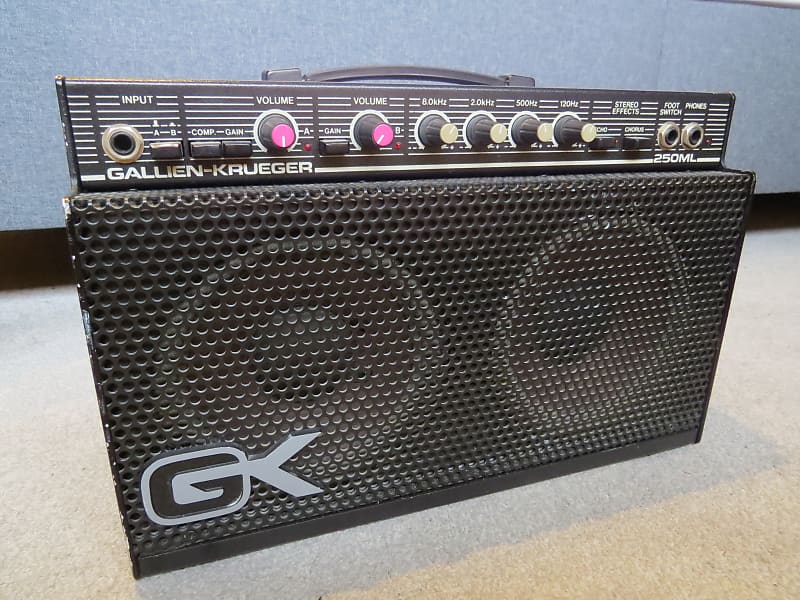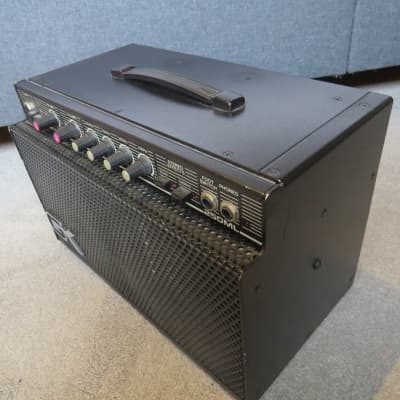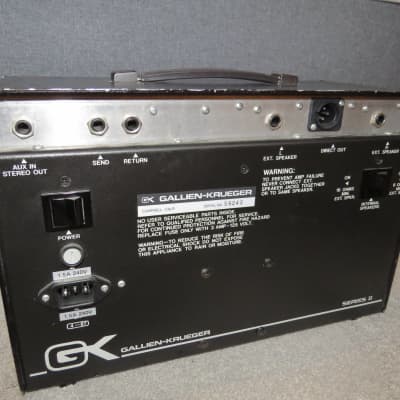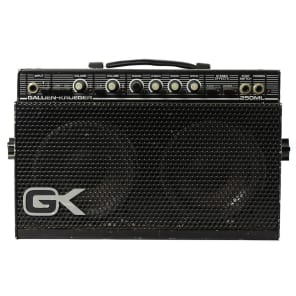A small piece of 1980s guitar amp history. This is an excellent example of this model, there are some light signs of wear but in very good condition. Has been tested and is in full working condition. If you need any pictures of any specific part of the amp, please message BEFORE buying.
- Available for delivery or collection from St Albans, Hertfordshire.
- U.K. Seller.
This is an article published about it at the time:
Article from International Musician & Recording World, December 1986
Gallien-Krueger's M-Series amplifiers have been making quite a name for themselves in professional circles: these diminutive combos have been snapped up by a host of guitarists ranging from Alex Leifson to Boon Gould, to say nothing of countless session players. So what's the attraction of the 250ML? Inside a package no bigger than a ghetto-blaster, this Californian company has stuck a twin channel, 50 watt per side stereo amplifier with solid state reverb, chorus, compression and a four-band eq, plus a couple of 6½" speakers. I suppose it's the musical equivalent of putting a Chevy engine into a Fiat Panda — and with similarly surprising results...
Bullet-Proof clothing
One of the biggest advantages of the 250ML, and indeed the whole range, is that of portability. This combo weighs in at 22lbs, which is light enough to carry some distance without discomfort. More than most amps, this means it's likely to come in for a bashing.
Certainly the exterior looks bullet-proof enough to cope. The whole thing is made from sheet metal, including the speaker grille, which adds a whole new meaning to the term 'kickproof'. The controls are set back behind the line of the grille to keep them clear of flailing Fenders. Still, even though it looks like you could happily explode grenades inside it, the 250ML manages to avoid looking too agricultural: in fact the silky black enamelled finish, with grey graphics and red LED status indicators, give it a distinctly hi-tech appearance.
All of this isn't much use if the components inside are left to shake, rattle and roll. Thankfully, this is not the case, as all the electronics (bar the transformer) are mounted on a single large PCB behind the control panel. Connections to and from the board are plug-in, and integrated circuits are used quite extensively. In the unlikely event of anything going wrong, it ought to be easy enough to fix.
The speakers and transformers are housed in a separate sealed enclosure. It really is sealed, too, with rubber strips on the connecting surfaces in addition to white goo on some of the joints — presumably to keep moisture (and prying fingers) out. The speakers aren't giving away their origin, but have chunky magnets which look a bit reminiscent of EVs.
I was slightly surprised to find no cooling fins for the transformer, though I have no doubt that Gallien-Krueger have done their sums and decided that none were necessary. I was more concerned at the lack of trim pots for the preset effects like the chorus, which the manual says can be internally adjusted. It could be that adjustment is made by swapping ICs, either way, you won't find many user-serviceable parts in here!
Sounds Wicked
When first faced with the 250ML, I foresaw two drawbacks. One of these was poor sound dispersion, the other was that it would be difficult to regulate the amount of distortion, as the 'conventional' arrangement of pre and post gain controls is simplified into a gain button and a volume pot for both channels.
In a point of fact, these turn out to be two of its strongest points. While some of the more ear-slicing frequencies are inevitably lost if you don't stand directly in front of the speakers, the amp is loud enough to be audible wherever you are on stage (so you can duck walk in complete confidence). The 2 x 50 watt output is certainly adequate for smaller gigs, and if the sound needs to be spread about a bit more, you simply tack on a couple of 4x12s, thus retaining the advantages of the stereo effects.
Getting the right amount of distortion is no problem either. Channel A without the gain feature is clean up to very high volume levels — depending in part on your guitar — while switching the gain in roughens up the edges of your sound whatever level you're at. The compressor on channel A is handy for adding a bit more sustain when you don't want distortion, though as both channels appear to incorporate limiter circuitry anyway the difference isn't as marked as you might expect. Channel B, intended for lead work, sounds very crunchy and contemporary, while the gain button is for those manic moments of Halenesque soloing (you may gather I had fun with this amp.) If you don't like the gain or compressor settings, these can be altered, although as I said earlier I'm not sure how...
The amount of distortion doesn't vary greatly according to the position of the volume knob. This means you have effectively four settings, from clean to filthy, which might sound like a limitation, but in practise all are very useable and can be tailored more effectively with the eq. The advantage is that you can practise at low levels and still get the sound right.
The four band eq has its centre frequencies at 8kHz, 2kHz, 500Hz and 120Hz, with unspecified amounts of cut and boost. It's a very powerful circuit, and all four controls make an immediate and definite difference to the sound, whether it's clean or distorted. They aren't interactive, so that you can whack the treble up without losing bass, and vice versa. While they won't turn your Jedson into a Gibson, they do make it very easy to tailor your sound to suit the occasion.
Then there are those two innocuous little buttons marked 'Echo' and 'Chorus'. Gallien-Krueger would have been justified in picking these out in dayglo orange, as they transform this amp from being a very capable performer into the only tool that a session player needs — apart from his guitar, dummy.
Both are stereo: since the amplifier is also stereo, and two speakers are provided, you can reap the benefits without having to drag another amp and cabinet around with you. The headphone socket is in stereo, too — so you can revel in the effects without having to share them with your less appreciative neighbours.
The echo is more akin to a reverb, in that the delay time is very short, but there's no spring noise (because there's no spring), and it is quite clean enough for studio work. The chorus is, to my mind, even better — just plug in, switch on channel A and the chorus, and you've got exactly the sound you've heard on countless records and never quite achieved before. 'Lush' isn't in it! There is a bit of oscillator noise, and a slight electronic 'click' when the effects are engaged, but not enough for the engineer to fling the chinagraph pencil at you.
Socket to Me
As you'd expect for the money, the 250ML is well equipped with all the natty little sockets for separate external speakers, effects loops, DI out, and all that jazz. Although there's only one input on the front, there's a handy 'aux in/stereo out' socket on the back: you can either stick Max Bygraves through your G-K in living stereo while you play along, or hook it up to any mixer that doesn't have a cannon socket. This is another indication of the way those awfully nice Gallien-Krueger people have designed the 250ML with the practicalities of rehearsing, recording and live performance in mind.
As well as the headphone socket, there's a hole for the optional footswitch, which lets you change channel and switch your preset stereo effects on and off. Unfortunately, you can't punch the gain buttons in and out remotely, which could be a real asset during live work. Perhaps the designers thought it would make the footswitch look too much like Concorde's flight deck.






